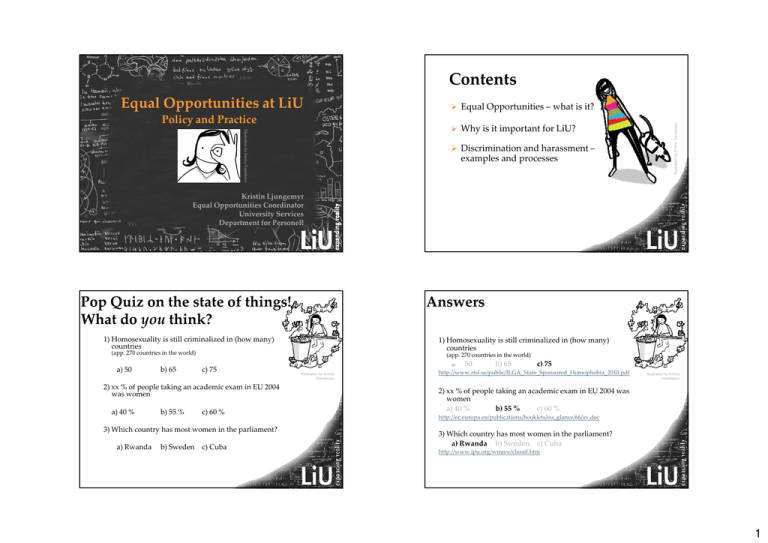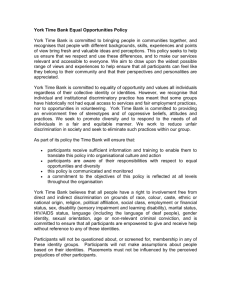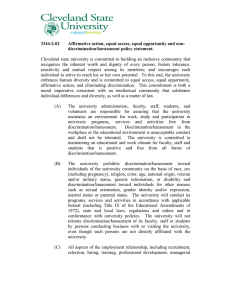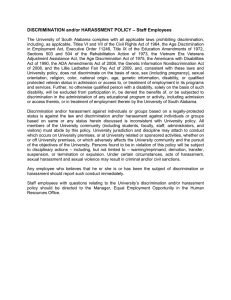
Contents
Policy and Practice
Equal Opportunities – what is it?
Illustration by Emma Danielsson
Why is it important for LiU?
Discrimination and harassment –
examples and processes
Illustration by Emma Danielsson
Equal Opportunities at LiU
Kristin Ljungemyr
Equal Opportunities Coordinator
University Services
Department for Personell
Pop Quiz on the state of things!
What do you think?
Answers
1) Homosexuality is still criminalized in (how many)
countries
1) Homosexuality is still criminalized in (how many)
countries
(app. 270 countries in the world)
a) 50
b) 65
(app. 270 countries in the world)
c) 75
2) xx % of people taking an academic exam in EU 2004
was women
a) 40 %
b) 55 %
c) 60 %
3) Which country has most women in the parliament?
a) Rwanda
b) Sweden
c) Cuba
a)
Illustration by Emma
Danielsson
50
b) 65
c) 75
http://www.rfsl.se/public/ILGA_State_Sponsored_Homophobia_2010.pdf
Illustration by Emma
Danielsson
2) xx % of people taking an academic exam in EU 2004 was
women
a) 40 %
b) 55 %
c) 60 %
http://ec.europa.eu/publications/booklets/eu_glance/66/sv.doc
3) Which country has most women in the parliament?
a) Rwanda b) Sweden c) Cuba
http://www.ipu.org/wmn-e/classif.htm
1
Equal Opportunities
LiU:s umbrella term for the work towards diversity and gender
equality, including efforts to combat discrimination,
harassment and other unfavourable special treatment.
I treat everybody
the same way!
Illustration by Emma Danielsson
Definitions
Equal Opportunities –
what is it?
Diversity
Illustration by Ulf Frödin
A mix of differences and similarities in, for example, sex and
gender, age, sexual orientation, ethnic origin, religious or other
belief system, disability and social background.
When an individual is treated unfairly, (i.e. worse than another
person is treated, has been treated, or would have been treated
in a comparable situation) on the basis of sex, ethnic
background, religion, sexual orientation, disability, age or
transgender identity or expression
Unfavourable special treatment and
harassment
The terms ‘unfavourable special treatment and harassment’
cover recurrent and unwelcome behaviour that violates
personal integrity – regardless of the reason.
Why is it important?
A good work and
study environment
Strategic quality
improvement
Human rights
and the law
Mr.
Ms./Mrs.
Illustration by Ulf Frödin
Discrimination
Gender equality is a matter of the relative equality of the sexes,
and means that women and men have the same rights,
obligations and opportunities in all essential areas of life.
Illustration by Emma Danielsson
Definitions
Gender equality
”Others”
2
Slut!
Sorry to hear,
I’m a medical
student
myself!
Human rights
and the law
“All human beings are born free and equal in dignity and
rights.”
Illustration by Ulf Frödin
From the UN Declaration of Human Rights
Discrimination Act
The purpose of this Act is to combat discrimination and in
other ways promote equal rights and opportunities regardless
of sex, transgender identity or expression, ethnicity, religion or
other belief, disability, sexual orientation or age.
Equality Ombudsman
The Equality Ombudsman (DO) is a government agency that
works against discrimination and for equal rights and
opportunities for everyone.
As a student…
The act includes:
Prohibition against discrimination and harassment
Prohibition against victimisation/retaliation
The university is obligated to:
take preventive action and preclude harassment
investigate and take action against harassment
have an annual plan & take active measures
Students are obligated to:
Treat each other and teachers/employees with respect
(= prohibited to discriminate or harass anyone)
Understand that your studies is No1
Above the surface
Examples of often-visible diversity:
Skin-, hair-, and eye color,
sex, age group, certain disabilities,
body size, the clothes we wear
Beneath the surface
www.breaktaker.com/.../amazing/Iceberg.jpg
Examples of less visible diversity:
Ethnic belonging, religion or
other faith, work skills, life
experience, family situation,
social background, sexual
orientation, languages spoken,
certain disabilities,
3
Equal Opportunities and
strategic quality improvement
Annual strategies and action plans
Linköping University Strategy and Action Plan for Equal
Opportunities, 2010
Local action plans at all Departments and Units
“Diversity can bring huge benefits in the workplace.
Companies are increasingly recognising that diversity is not
just a moral argument or a question of meeting legal
obligations. In a 2005 EU Commission report, 83% of companies
with a diversity policy in place said that it had brought real
business benefits.
Source: http://ec.europa.eu/employment_social/eyeq/index.cfm
Examples of proactive measures
Rooms for Reflection – Andrum
Information and education
Multi religious calendar for all
departments and units
Student and Employee surveys
Services for students with disabilities
- Includes both students and employees
Sometimes it’s just a
matter of having the
right equipment
Illustration by Ulf Frödin
A diverse workforce is one with different perspectives and
different ideas. Public authorities and private companies serve
and address people with a wide range of backgrounds. By
reflecting this in their own workforce, they are better equipped
to understand their needs. Diversity makes business sense.”
- Cover all forms of discrimination and harassment
”It’s so far up north and it
would probably be cold all the
time.”
”Swedes tend to be thoughtful
and intellectual.”
”Sweden is a peaceful country
where nothing out of the
ordinary happens.”
4
Equal Opportunities as a Student and Employee to be
You
Equal Opportunities
Victimisation, discrimination and harassment –
examples and processes
Other students/
Colleagues
Who can I
talk to?
What are my
options?
Customers/clients/
teachers/others
Their
families
Illustration by Emma Danielsson
The risks of victimisation, discrimination and
harassment rise if one or more of the following
phenomena are present:
restricted freedom of action or difficulties in influencing one’s
study situation
insufficient stimulation or too much stress
unclear objectives, rules and routines, or other uncertainty
poor leadership, for example if a supervisor or teacher lacks
basic knowledge of individual and group processes
power abuse in any form, such as systematic favouritism
Signals
Possible signs that victimisation, discrimination or
harassment is going on:
repeated complaints about an individual or study
situation
someone seems excluded from the study group
someone is absent more often and/or performs less
well than before
someone has a constant wish to move to another
study group
competition or envy that makes people control
each other
5
Some examples
What would you do if you were in this class or
group?
• A professor makes a derogatory comment in front of
the whole class about one particular student’s
religious beliefs.
• Student ”A” in your study group often tries to get
close to and touch (pat, kiss, hug etc) student ”B”.
Student B makes very clear that she/he is not
interested in this, but the behaviour continues.
If you have experienced discrimination or
harassment, you can turn to:
►
Your Head of department, program, or course
►
Representatives of the Student Union
►
Student Health Services (duty to provide confidentiality)
►
Academic Guidance Counsellors (duty to provide confidentiality)
►
Equal Opportunities Coordinators
►
The National Ombudsman against Discrimination
Who determines whether you have been
harassed or discriminated against?
It is always the subjective perception of the individual subjected
to such treatment that determines what is offensive.
However, the presence of offensive behaviour does not always
mean that acts constitute discrimination or harassment in relation
to the law.
How can this be prevented?
Think about your choice of words, response and
conduct, and respect others.
React to unacceptable behaviour or offensive
remarks by others.
Keep communication open and provide clear
information
In group work, discuss the climate of cooperation,
for example.
They can provide advice and support and help you solve the
problem, or point you to someone who can.
If you are not satisfied with the solution or outcome you can
lodge a formal complaint or report to the University.
6
Contact information
www.liu.se/likavillkor
likavillkor@liu.se
http://www.studentservices.utas.edu.au/equity/just_talk/U%20of%20Tas%201.gif
Useful links:
Career Service center
http://www.student.liu.se/karriarcentrum?l=en&sc=true
Swedish for foreign students
http://www.liu.se/ikk/svenska-for-utlandskastudenter/collegeutbildningen?l=en&sc=true
7



